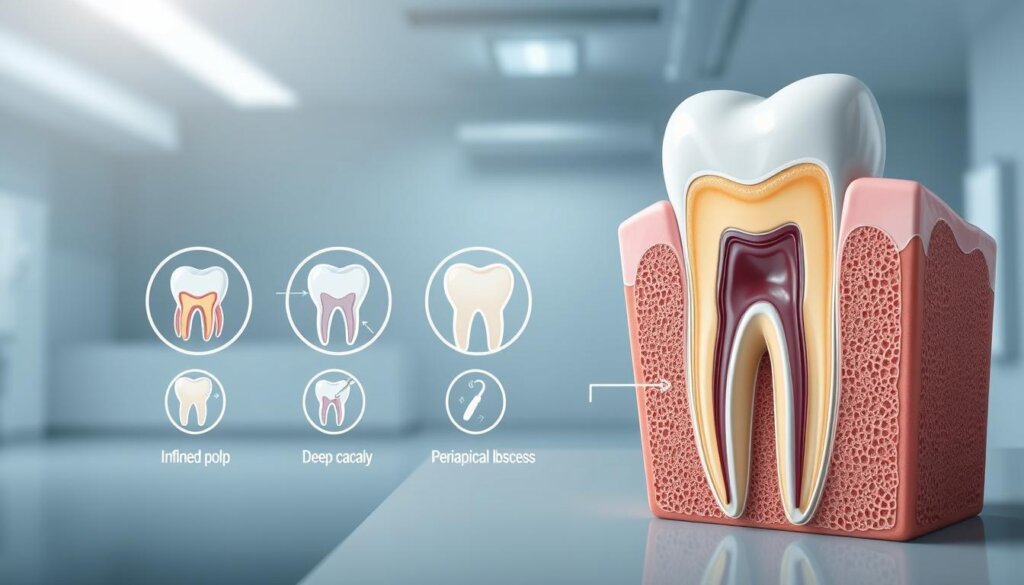Why Would I Need a Root Canal?
Every year, over 15 million root canals are done in the U.S., says the American Association of Endodontists. This might make you wonder, “Why would I need a root canal?” It’s to remove infected pulp from deep decay or trauma. This way, the tooth can be saved from being pulled out.
Experts at Cleveland Clinic explain that these infections don’t heal by themselves. This shows why quick action is needed.
Root canals are often needed for a cracked tooth or a big cavity. Thanks to new techniques and painkillers, the procedure is much less painful. Saving a tooth can also prevent other teeth from moving and jaw problems later on.
Key Takeaways
- Root canal therapy addresses infected pulp within a tooth.
- Timely care supports the body’s capacity to heal.
- Preserving the natural tooth helps maintain normal chewing.
- Advanced methods reduce pain and discomfort.
- Cleveland Clinic emphasizes that untreated infections can get worse.
- Common reasons for root canal include deep decay or tooth damage.
Understanding Root Canals
Dental experts see root canals as key when the pulp inside a tooth gets inflamed or infected. Signs like persistent pain, swelling, or deep tooth decay mean it’s time for this treatment. The Mayo Clinic says it cleans out the tooth’s root canals to remove damaged tissue.
Modern dental tech, as shown by the American Association of Endodontists, makes the process less scary. It used to be feared, but now it’s more comfortable.
Definition of a Root Canal
A root canal is both the space inside a tooth’s root and the process to fix it. It cleans out the canal to stop bacteria from spreading. Here are some signs that might mean you need to see a dentist.
| Common Indications | Associated Symptoms |
|---|---|
| Inflamed or Infected Pulp | Persistent Sensitivity |
| Deep Tooth Decay | Ongoing Pain or Swelling |
| Fractured Root Structure | Difficulty Chewing |
Importance of the Procedure
Keeping your natural tooth helps your bite stay right and avoids problems from pulling it. It stops the decay from getting worse and seals it to keep bacteria out. Dentists often suggest fixing it up afterward to keep your smile and comfort.
By doing this, you get better oral health and peace of mind.
Common Causes for a Root Canal
Root canal treatment is needed when the tooth’s inner pulp is at risk of infection or damage. Issues like complex decay, dental trauma, or a cracked tooth can cause bacteria to invade. Getting endodontic care early helps save the tooth and keeps your mouth healthy.
Deep Decay
Deep decay happens when bacteria get past the tooth’s protective layers. This weakens the tooth and lets harmful microbes reach the pulp. Catching it early and cleaning it well can prevent serious infections.
Traumatic Injury
Getting hit in the mouth during sports or accidents can hurt the tooth’s nerves. The Canadian Dental Association says severe injuries can expose internal tissues, causing inflammation. Root canal therapy protects the pulp and stops long-term problems.
Cracked Teeth
Small cracks can grow if not treated. They let bacteria into the root canal system. Getting treatment quickly helps avoid deeper infections and keeps your tooth intact.
Symptoms Indicating a Root Canal
Spotting early signs can spare prolonged discomfort. Dental professionals warn that unresolved issues may escalate and lead to abscess formation. An infected tooth pulp sometimes triggers noticeable pain alongside systemic concerns that demand attention.
Persistent Toothache
Throbbing aches that linger or flare during chewing are often tied to pulp inflammation. Some patients describe pain that worsens at night. Such discomfort tends to deepen if the infected tooth pulp is left unchecked.
Sensitivity to Hot or Cold
Lingering twinges after sipping warm beverages or tasting cold snacks may signal nerve damage. Extended sensitivity points to possible pulp irritation. Specialists advise prompt evaluation to rule out an infected tooth pulp.
Discoloration of the Tooth
Gradual darkening or a grayish tint could reveal internal harm. The Cleveland Clinic advises rapid response if any boil or swelling appears on the gums. These signs suggest serious underlying issues.
Some warning clues include:
- Swollen or tender gums
- Sharp twinges when biting
- Unpleasant taste near the affected area
| Symptom | Possible Cause | Recommended Action |
|---|---|---|
| Persistent Toothache | Pulp Inflammation | Schedule an Examination |
| Temperature Sensitivity | Nerve Irritation | Obtain a Dental X-Ray |
| Discoloration | Internal Damage | Seek Immediate Treatment |
Diagnosing the Need for a Root Canal
Many dentists use advanced methods to figure out if a root canal is needed. Mayo Clinic studies show that imaging can find hidden cavities. It’s important to act fast to save as much of the tooth as possible.
We use a mix of looking at the tooth, checking the patient’s history, and modern tools. This way, we protect your teeth and avoid bigger problems.
Role of Dental X-Rays
X-rays show what’s inside the tooth. They help find decay that’s hidden, like cavities near the nerve.
Clinical Examination
Dentists check how the tooth reacts to cold or pressure. They might tap on the tooth or feel the area around it to see if there’s infection.
| Diagnostic Tools | Function |
|---|---|
| X-ray Imaging | Reveals hidden issues |
| Sensitivity Testing | Determines pulp health |
| Palpation | Identifies local inflammation |
How Root Canal Treatment Works
This procedure aims to save a tooth when infection hits the pulp. Tooth sensitivity often means the inner tissue needs a deep clean. This careful approach helps prevent more damage.
Dental experts check the area and pick the best method for success. Each step targets a specific problem in the tooth.
Step-by-Step Process
Mayo Clinic has a step-by-step guide to remove infected tissue and make the tooth stable:
- Local anesthetic is given to numb any discomfort.
- A tiny opening is created on the crown.
- Infected pulp and debris are taken out.
- The canal is disinfected and shaped for filling.
- Gutta-percha is placed to seal the canal.
- A permanent filling or crown completes the repair.
Pain Management During the Procedure
Modern anesthetics control pain at every step. Patients feel less tooth sensitivity from start to finish. Pharmacological strategies and precise instruments help keep stress low. This creates a calm atmosphere during treatment.
Risks of Delaying Treatment
Ignoring tooth pain can lead to serious problems. Experts at Cleveland Clinic and the Canadian Dental Association say untreated root infections often cause dental abscesses. This can harm the surrounding areas and threaten your health.
Potential for Increased Infection
Ignoring tooth pain can let bacteria grow more. This can cause:
- Extreme swelling around the tooth
- Damage to nearby bone tissue
Acting quickly can stop severe infection and prevent it from spreading. It also lowers the risk of serious health problems.
Spread of Decay to Adjacent Teeth
Ignoring one tooth can harm all your teeth. Bacteria can spread to other teeth, causing more pain. This can weaken your teeth and lead to more problems.
Getting treatment quickly helps keep your teeth healthy. It protects your bones and stops new decay from starting.
Post-Procedure Care
Taking care of your tooth right after treatment is key. The Canadian Dental Association says to avoid chewing on the treated area. This helps the tooth heal faster. Brush gently around the area and use an antiseptic rinse if your dentist tells you to.
If you notice swelling or pain that won’t go away, see your dentist right away. This could mean there’s a problem that needs attention.
Immediate Aftercare Tips
Eat soft foods to keep the tooth safe. This lets the tissues heal without stress. Here are some tips:
- Brush with a gentle technique
- Avoid sticky or hard foods
- Use pain relievers as directed by the dentist
Long-term Care Suggestions
Regular dental checkups are important. They help catch any problems early. Brush and floss regularly to prevent bacteria buildup. This lowers the risk of getting another dental abscess or infection.
| Timeframe | Recommended Actions |
|---|---|
| First 24 Hours | Stick to soft foods, monitor for pain or swelling |
| First Week | Continue gentle brushing, follow-up with your dentist if needed |
| Ongoing | Schedule regular exams, maintain thorough oral hygiene |
Alternatives to Root Canal Treatment
In modern dentistry, saving teeth is a top goal. But, sometimes, other options are needed. Patients might wonder, “Why would I need a root canal?” when facing deep decay or infection.
Dentists often look at the Mayo Clinic and the American Association of Endodontists for guidance. This helps them find the best alternative.
Deciding if a tooth can be saved depends on several factors. Severe damage might mean other treatments are better. These options vary in complexity and results.
Extraction of the Affected Tooth
When a tooth is too damaged, it might need to be removed. This can stop pain and infection. Afterward, options like implants or bridges can replace the tooth.
Pulp Capping Procedures
Early infection can be treated with a protective dressing. This method is used for small decay. It’s a temporary fix that might delay more serious treatments.
| Procedure | Reason | Potential Outcome |
|---|---|---|
| Extraction | Extensive structural damage | Eliminates source of infection but requires a replacement |
| Pulp Capping | Early or minimal pulp exposure | May preserve vital tissue, though not guaranteed long-term |
Success Rate of Root Canals
Dental experts often see great results with root canals. They can save a tooth by removing the bad tissue. This care fixes the infection and makes the tooth strong again.
Even tough cases can be fixed with root canals. The American Association of Endodontists says success rates are over 90% in many cases. This is thanks to new tools and techniques.
Statistics on Efficacy
Studies show big improvements in teeth that get good care after treatment. Modern tools help dentists see and clean the inside of teeth well. This lowers the chance of infection coming back.
Factors Affecting Success
Every tooth is different. Good planning and patient care can keep a tooth strong. Taking care of your tooth at home and seeing your dentist regularly helps too.
| Factor | Influence on Outcome |
|---|---|
| Infectious Load | Heavier infection may increase treatment steps |
| Canal Complexity | Curved or branching canals demand specialized techniques |
| Aftercare Routine | Consistent hygiene and regular visits support tooth longevity |
Financial Considerations
Patients often think about the cost of root canal therapy and the risks of not treating tooth decay. Is it better to save a natural tooth to avoid more expensive procedures? Many believe that taking preventive steps can save money on dental implants or surgical extractions.
Early treatment of tooth decay can sometimes avoid the need for complex restorative work. Cleveland Clinic notes that quick action can save money on advanced infections or tooth removal. Keeping a tooth healthy is a smart choice that can prevent future problems.
Cost of Root Canal Treatment
The cost depends on the tooth’s location and the extent of damage. Dental experts consider the overall health of the mouth and the complexity of the decay. Getting a cost estimate before treatment helps plan, comparing options like crowns or tooth removal.
Insurance Coverage for Procedures
Insurance plans vary, but many cover root canals as essential. While partial reimbursement is common, it shows how important root canals are for serious tooth decay. Knowing your insurance benefits before treatment helps plan financially.
| Factor | Possible Range | Potential Impact |
|---|---|---|
| Location of Tooth | Front vs. Molar | Influences complexity |
| Decay Severity | Mild to Extensive | Can alter total costs |
| Insurance Plan | Partial to Major Coverage | Reduces out-of-pocket |
Myths and Misconceptions
Many patients hear stories that make them hesitant to get care. They might believe these rumors and end up with more problems. The Canadian Dental Association and the Canadian Academy of Endodontics say root canals don’t lead to big health issues.
Modern methods and precise anesthesia make the procedure comfortable for most. This is a fact that counters many myths.
Common Myths About Root Canals
Some myths say root canals are more painful than tooth removal. Others claim they cause serious illnesses. These myths can make people scared when they need dental care.
Clarifying Misunderstandings
Experts advise keeping natural teeth after dental trauma. This is safer and more cost-effective for long-term health. Learning more about dental care helps clear up old myths and builds trust in root canal treatments.
Choosing the Right Specialist
Choosing the right specialist for an infected tooth pulp is key to a successful root canal. Some cases seem simple, but complex infections need special care. The Canadian Dental Association says that complex root anatomy should be handled by an endodontist. They have the training for tough procedures.
The choice depends on the infection’s severity and the tooth’s structure. A dentist can handle common issues. But, an endodontist is best for teeth with complex root canals.
Dentist vs. Endodontist: Who to Choose?
Dentists and endodontists both have important roles. Dentists do many things. Endodontists focus on tooth pulp infections and use special tools for root canals.
Questions to Ask Your Provider
It’s good to know your specialist’s background:
- How many root canal cases they’ve done
- How often they succeed
- The tools and methods they use for diagnosis
- What the recovery plan and follow-ups will be
Importance of Regular Dental Checkups
Routine dental visits help protect your teeth from serious damage. Mayo Clinic says that regular checkups and cleanings can catch small cavities early. This helps keep your teeth strong and avoids more complicated dental problems.
Preventive Care and Early Detection
Regular X-rays and dental exams can spot early signs of tooth wear. Catching problems early means quicker and easier fixes. This can stop infections and save you from needing expensive treatments.
How Checkups Help Prevent Root Canals
Ignoring a small cavity can lead to bigger problems. Regular dental visits can prevent this. Dentists check your teeth and give tips on how to keep them healthy. By going to the dentist regularly, you can avoid root canals and feel more confident about your smile.
Conclusion: Making the Decision
Experts like Cleveland Clinic, Mayo Clinic, and the Canadian Dental Association stress the need for quick action. Ignoring tooth sensitivity or pain can lead to serious infections and dental abscesses.
Root canal therapy can save your natural tooth and prevent future problems. Modern endodontics use safe methods that protect your teeth. Early detection helps you choose the right treatment without enduring too much pain.
When to Seek Treatment
If you have ongoing aches or inflamed gums, see a dentist right away. Waiting can cause more harm or damage to your tooth. Regular dental checks prevent small issues from becoming big problems.
Finding Peace of Mind in Dental Care
New dental science and better pain management options make many feel more comfortable. Specialists aim to keep your teeth healthy and pain-free. Getting professional advice and acting quickly ensures a pain-free future. Saving your natural teeth brings peace of mind in your dental care journey.





